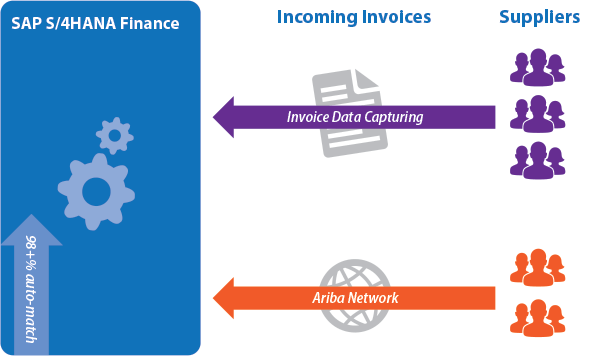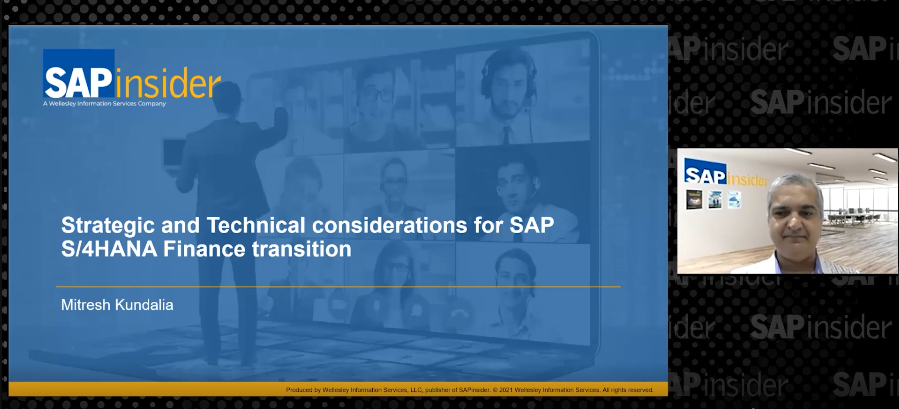Gain Insight and Take Action
How SAP S/4HANA Finance and the Ariba Network Improve Visibility and Collaboration
Communicating directly with buyers, suppliers, and external business partners along every step of the procure-to-pay (P2P) process has traditionally been outside the realm of even the most sophisticated finance operations teams. Many of the reasons for this boil down to the fact that the finance organization has, historically speaking, focused its energies on internal process optimization, with little focus on the parts of the process that cross company lines or business unit silos.
However, in a highly connected business-to-business (B2B) digital economy that values visibility and immediacy in the movement of goods and services along the extended supply chain, finance can no longer afford to be separated from its business partners both within and outside its company. Rather, finance organizations need to play a central role in a P2P value chain that connects buyers, suppliers, and even value-added partners such as banking institutions into a central hub. Creating this collaborative hub is of particular importance for the SAP community now that the Ariba Network is an integral part of the SAP ecosystem, which significantly changes how buyers, suppliers, and partners interact and collaborate.
For the finance organization to jump into the fray, a few things have to happen. First, the traditional reputation of finance operations as an organization dedicated to internal process optimization must shift to one in which finance strives to become a fully strategic arm of the business. Second, by connecting to a business network, accounts payable (AP) and accounts receivable (AR) teams must deliver real-time insights — made possible with SAP HANA — that allow finance to make informed and timely planning and forecast decisions, manage invoices better, and manage key performance indictors (KPIs) around the business’s overall cash position.
This is insight to action, and it is one of the key value propositions of SAP S/4HANA Finance, SAP’s next-generation business platform that consolidates various finance functions into a digital core. Within this core, insight to action is possible because of a new application architecture that eliminates indices and aggregates, with SAP HANA serving as the driving engine directly in the application itself. By eliminating the need for batch processing, and with embedded analytics ensuring contextual information, SAP S/4HANA Finance provides the finance organization with the platform it needs to reach its goal of becoming a strategic partner to the business.
This is what we mean by network-centric finance, and it is the model of the future for companies that are serious about competing in a connected economy (see Figure 1).

Shine a New Light on Invoice Management with Business Networks
The growing complexity of business processes and the growing need to collaborate with business partners in a digital economy are the main factors in the need for finance to become strategic, rather than remain in its customary role of interacting with suppliers for routine invoicing concerns. With the Ariba Network integrating buyers, suppliers, and value-added partners and services into a single connection point, finance has unprecedented visibility into the status of accounts. It also has an unprecedented ability to move documents where they need to be to ensure invoices are approved and paid, and to make sure the workflow automatically pulls the necessary information into the back-end reconciliation system. An integrated business network provides finance with a real-time snapshot of which invoices are being paid and when they are being paid, which traditionally has been accomplished mainly via emails and phone calls.
This increased visibility certainly adds value to finance operations, but insight to action drives additional value by providing finance with the ability to actually move information back and forth between buyers and suppliers. To illustrate the value this brings, we can compare it to electronic data interchange (EDI), a point-to-point solution that likewise moves a lot of data between a single buyer and supplier. Anyone familiar with EDI knows that this information exchange is static, meaning nothing happens as it is transmitted from supplier to buyer. Within the context of an integrated business network, that information becomes visible to key stakeholders who can validate and analyze the data and correct potential errors or exceptions during transmission.
The Ariba Network automates and provides complete visibility into invoicing collaboration between buyers and suppliers — a process that finance has always been responsible for, but has never had the technology to optimize.
Examples of the benefits this provides are numerous. For starters, with an integrated business network, finance can predefine and automate rules for invoice exceptions, so documents are pushed back to suppliers online and in real time. By the time an invoice actually reaches AP, most, if not all, exceptions have been handled without any human intervention (see Figure 2). Also, with complete visibility into the status of an invoice, there no longer has to be a rigid point-to-point system where an invoice is sent and no action is taken until payment. Instead, finance can drive greater efficiencies by collaborating with buyers on discounts for early payments and making short-term cash investments with the difference.

A business network also eliminates the headaches that come from reconciling adjustments on multiple invoices for situations such as credit adjustments or an incomplete delivery. Because AR cannot recognize revenue until such reconciliation occurs, this has always been an important yet arduous task with imperfect workarounds. In an integrated business network, all of the information related to payment, such as purchase orders, invoices, receipts, and shipping notifications, is already being transmitted, so it is easy to attach supporting documentation to simplify invoice reconciliation and significantly reduce the investigative back-and-forth between AP and AR.
Last, a business network can eliminate the disconnect between the invoice and the details of the procurement contract that AP often experiences. Contract leakage can equate to a significant loss in revenue, a truth to which the post-audit recovery industry can attest. A business network automates invoice payment and can send discrepancy alerts.
A business network such as the Ariba Network automates and provides complete visibility into invoicing collaboration between buyers and suppliers — a process that finance has always been responsible for, but has never had the technology to optimize.
Supercharge the Business Network with Real-Time Finance
While it is clear that the visibility and collaborative opportunities offered by the business network can simplify many finance tasks, true network-centric finance requires finance operations to move to a real-time platform. Receiving real-time information through a business network means little if finance does not have the tools required to turn insight to action, so here we will explore in more detail how SAP S/4HANA Finance enables real-time network finance operations.
SAP’s Ariba acquisition coincided perfectly with the need — and readiness — of many finance organizations to look beyond the optimization of internal processes, or the use of shared services for core SAP ERP finance functionality, to include the optimization of processes that involve both suppliers and buyers. This need is driven by a transition to a digital economy that requires both immediacy and customer-centricity.
SAP S/4HANA Finance enables finance organizations to check the status of invoices in real time, and reconcile all information coming from the Ariba Network into the back-end system as a single source of truth.
SAP S/4HANA Finance enables finance organizations to check the status of invoices in real time, and reconcile all information coming from the Ariba Network into the back-end system as a single source of truth. With budgeting, forecasting, and analytics all rolled into SAP S/4HANA Finance, the finance organization can do more than reroute payments or capitalize on discounts — it can be far more proactive in future interactions with network partners. For example, with real-time information concerning a significant cash discount utilization change, or a change in future payables, finance could immediately engage with buyers and sellers based on these recalculations to improve any number of KPIs.
Finance needs to adopt the mindset that a real-time platform removes traditional barriers and presents almost limitless opportunities to engage and interact with buyers and suppliers in completely new ways. When the walls between procurement, finance, and trading partners are torn down, finance can finally step out from the back office and start on the path toward becoming a strategic partner that provides a customer-centric, service-first engagement in the business network.
Learn More
To learn more about how SAP S/4HANA Finance and the Ariba Network improve visibility and collaboration in finance operations, visit www.sap.com/finance and www.ariba.com/solutions/manage-cash.







